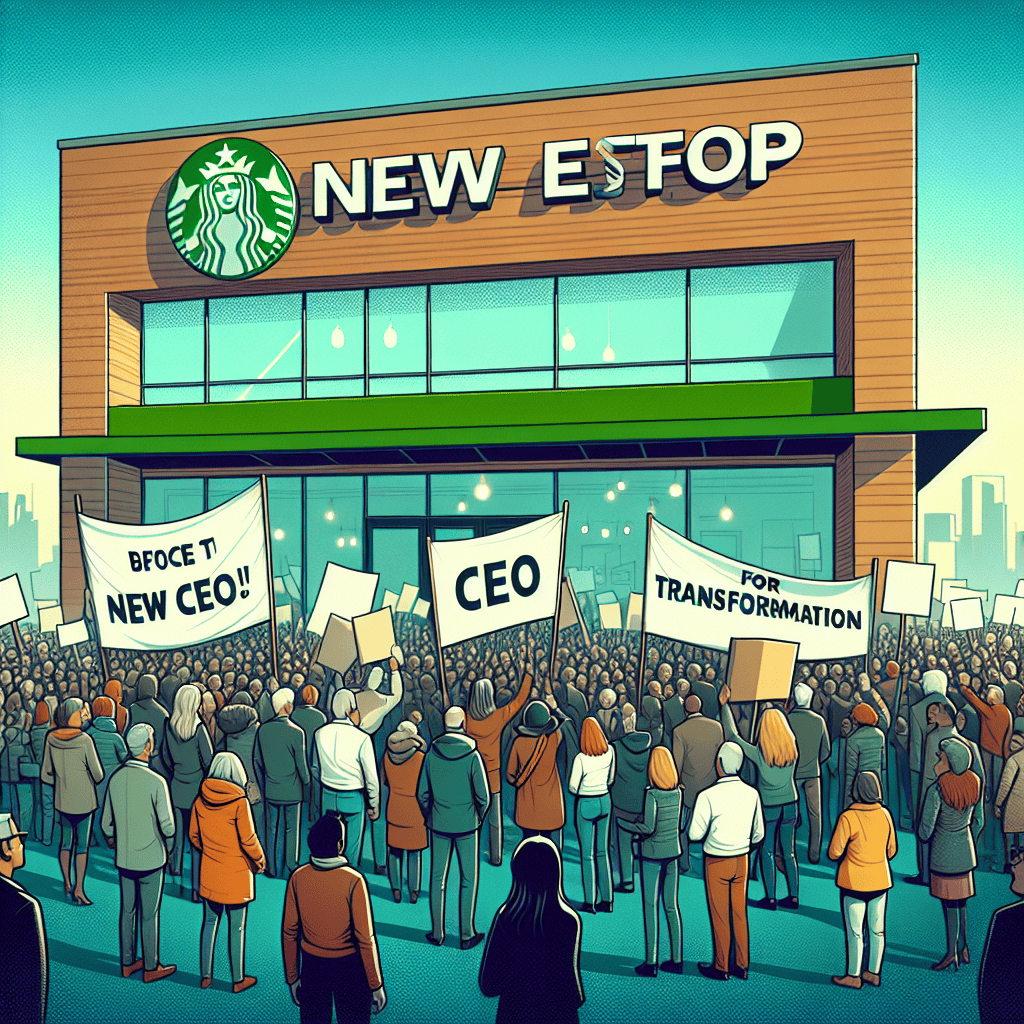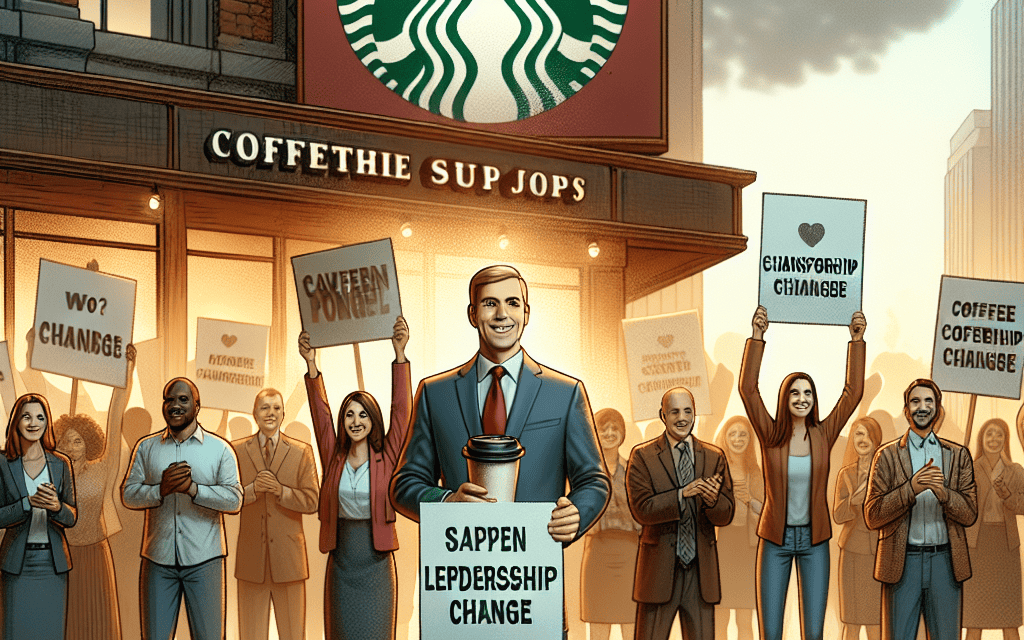“Brewing Change: A Community’s Call for Starbucks’ New Era”
Introduction
Starbucks, a global leader in the coffeehouse industry, is at a pivotal moment as its community of stakeholders—ranging from employees and customers to investors and social advocates—calls upon the newly appointed CEO to spearhead a transformative era for the company. This collective urging comes amid evolving consumer expectations, heightened awareness of social and environmental responsibilities, and the need for innovative growth strategies in a competitive market. The new CEO faces the challenge of balancing Starbucks’ rich heritage with the demand for progressive change, ensuring the brand remains relevant and resilient in a rapidly changing world.
Leadership Change: The Call for a New Vision at Starbucks
In recent months, the Starbucks community, comprising employees, customers, and stakeholders, has increasingly voiced a collective call for transformation under the leadership of a new CEO. This growing sentiment reflects a desire for a fresh vision that aligns with the evolving landscape of the global coffee industry and the shifting expectations of its diverse clientele. As Starbucks continues to be a dominant force in the market, the need for innovative leadership has become more pronounced, particularly in the face of emerging challenges and opportunities.
The call for a new vision at Starbucks is rooted in several key factors. Firstly, the rapid pace of technological advancement has significantly altered consumer behavior, with a marked increase in demand for digital engagement and personalized experiences. Customers now expect seamless integration of technology in their interactions with brands, from mobile ordering to personalized marketing. Consequently, the Starbucks community is urging leadership that can adeptly navigate this digital transformation, ensuring that the company remains at the forefront of innovation while maintaining its core values.
Moreover, sustainability has emerged as a critical concern for both consumers and businesses worldwide. Starbucks, with its extensive global footprint, is uniquely positioned to lead by example in this arena. The community is advocating for a CEO who prioritizes environmental stewardship and implements strategies that reduce the company’s carbon footprint, promote ethical sourcing, and support sustainable farming practices. By doing so, Starbucks can reinforce its commitment to social responsibility and appeal to environmentally conscious consumers.
In addition to technological and environmental considerations, the Starbucks community is also focused on the importance of fostering an inclusive and equitable workplace. As societal awareness of diversity and inclusion issues continues to grow, there is an increasing expectation for companies to reflect these values internally. The call for a new CEO includes a demand for leadership that champions diversity, equity, and inclusion initiatives, ensuring that Starbucks not only attracts but also retains a diverse workforce. This approach not only enhances the company’s reputation but also drives innovation by bringing varied perspectives to the table.
Furthermore, the economic landscape presents its own set of challenges and opportunities for Starbucks. With fluctuating global markets and changing consumer spending habits, the company requires a leader who can adeptly manage financial performance while investing in long-term growth. The community is looking for a CEO who can balance cost management with strategic investments in new markets and product lines, thereby securing Starbucks’ position as a leader in the coffee industry.
As the Starbucks community continues to advocate for a new vision, it is clear that the next CEO will play a pivotal role in shaping the company’s future. The ideal leader will not only address the immediate challenges but also anticipate and adapt to future trends, ensuring that Starbucks remains a beloved brand worldwide. By embracing innovation, sustainability, inclusivity, and financial acumen, the new CEO can drive the transformation that the community so fervently desires.
In conclusion, the call for a new vision at Starbucks underscores the community’s commitment to progress and excellence. As the company stands at this critical juncture, the selection of a new CEO presents an opportunity to redefine its trajectory and reinforce its status as a global leader. Through thoughtful and visionary leadership, Starbucks can continue to thrive in an ever-changing world, meeting the needs of its customers and stakeholders while staying true to its mission and values.
Employee Voices: What Starbucks Workers Want from a New CEO
As Starbucks embarks on a new chapter with the appointment of a new CEO, the voices of its employees resonate with a call for transformation. The global coffee giant, known for its iconic green siren and ubiquitous presence, is at a pivotal moment where the expectations of its workforce are more pronounced than ever. Employees, who are the backbone of the company, are expressing a desire for a leadership approach that not only acknowledges their contributions but also addresses the evolving challenges they face in the workplace.
One of the primary concerns among Starbucks employees is the need for improved working conditions. Over the years, the demands of the job have intensified, with baristas often juggling multiple tasks in a fast-paced environment. Consequently, there is a growing call for the new CEO to prioritize the well-being of employees by ensuring manageable workloads and adequate staffing levels. By addressing these issues, the company can foster a more supportive and sustainable work environment, which in turn can enhance employee satisfaction and productivity.
In addition to working conditions, fair compensation remains a critical issue for Starbucks employees. As the cost of living continues to rise, workers are advocating for wages that reflect their contributions and allow them to maintain a decent standard of living. The new CEO is expected to engage in meaningful dialogue with employees to understand their financial concerns and explore avenues for equitable pay structures. By doing so, Starbucks can demonstrate its commitment to valuing its workforce and retaining talent in a competitive labor market.
Moreover, employees are seeking a more inclusive and diverse workplace culture. Starbucks has made strides in promoting diversity and inclusion, yet there is a consensus that more can be done. Employees are urging the new CEO to implement policies that not only celebrate diversity but also ensure equal opportunities for advancement within the company. By fostering an environment where all voices are heard and respected, Starbucks can strengthen its reputation as a socially responsible employer.
Furthermore, the issue of employee representation is gaining traction among Starbucks workers. Many employees feel that their voices are not adequately represented in decision-making processes that directly impact their roles. As such, there is a call for the new CEO to establish more robust channels for employee feedback and participation. By creating platforms for open communication, the company can build trust and collaboration between management and staff, ultimately leading to more informed and effective business strategies.
In light of these concerns, Starbucks employees are also emphasizing the importance of leadership transparency. They are advocating for a CEO who is not only approachable but also willing to share insights into the company’s strategic direction and challenges. Transparency can bridge the gap between leadership and employees, fostering a sense of unity and shared purpose.
As Starbucks transitions under new leadership, the expectations of its employees are clear. They are calling for a CEO who will champion their needs and drive meaningful change within the organization. By addressing issues related to working conditions, compensation, diversity, representation, and transparency, the new CEO has the opportunity to transform Starbucks into a model employer that truly values its workforce. In doing so, the company can continue to thrive in an ever-evolving industry while maintaining the trust and loyalty of its employees.
Sustainability Goals: How a New CEO Could Drive Environmental Change
Starbucks, a global leader in the coffee industry, has long been recognized for its commitment to sustainability and environmental stewardship. However, as the company faces increasing pressure from both consumers and environmental advocates, the call for a transformative approach to sustainability has never been more pronounced. With the recent appointment of a new CEO, the Starbucks community is hopeful that this leadership change will catalyze a renewed focus on environmental goals, driving the company towards more ambitious and impactful sustainability initiatives.
The new CEO inherits a legacy of sustainability efforts that have laid a solid foundation for future progress. Starbucks has made significant strides in areas such as ethical sourcing, waste reduction, and energy efficiency. For instance, the company has committed to ethically sourcing 100% of its coffee and has made substantial investments in renewable energy. Despite these achievements, there is a growing consensus that incremental changes are no longer sufficient to address the pressing environmental challenges of our time. Consequently, stakeholders are urging the new CEO to adopt a more transformative approach that aligns with the urgency of the climate crisis.
One of the key areas where the new CEO could make a substantial impact is in the reduction of single-use plastics. While Starbucks has made efforts to introduce reusable cups and reduce plastic straws, these initiatives have not yet achieved the scale necessary to significantly reduce the company’s environmental footprint. By prioritizing innovation in sustainable packaging and expanding the availability of reusable options, the new CEO could position Starbucks as a leader in the fight against plastic pollution. Furthermore, by collaborating with other industry players and policymakers, Starbucks could help drive systemic change that extends beyond its own operations.
In addition to addressing plastic waste, the new CEO has the opportunity to enhance Starbucks’ commitment to carbon neutrality. The company has already set ambitious targets to reduce its carbon emissions, but achieving these goals will require a comprehensive strategy that encompasses all aspects of its supply chain. By investing in regenerative agriculture practices and supporting farmers in adopting sustainable methods, Starbucks can not only reduce its carbon footprint but also contribute to the resilience of coffee-growing communities. Moreover, by leveraging technology and data analytics, the company can optimize its operations to further minimize environmental impact.
Transitioning to a more sustainable business model also presents an opportunity for Starbucks to engage its customers in meaningful ways. The new CEO could spearhead initiatives that encourage consumers to participate in sustainability efforts, such as incentivizing the use of reusable cups or promoting awareness campaigns about the environmental impact of coffee production. By fostering a culture of sustainability among its customer base, Starbucks can amplify its impact and inspire broader societal change.
As the new CEO takes the helm, the Starbucks community is optimistic that this leadership transition will usher in a new era of environmental responsibility. By embracing bold and innovative strategies, the company has the potential to set a new standard for sustainability in the coffee industry. While the challenges are significant, the opportunity to drive meaningful change is equally profound. With a clear vision and a commitment to action, the new CEO can lead Starbucks towards a more sustainable future, ensuring that the company not only meets but exceeds the expectations of its stakeholders and contributes positively to the global effort to combat climate change.
Customer Experience: Transforming Starbucks for the Modern Consumer

In recent years, Starbucks has become a ubiquitous presence in the global coffee landscape, known for its distinctive green logo and inviting atmosphere. However, as consumer preferences evolve and the competitive landscape intensifies, the Starbucks community is increasingly urging the company’s new CEO to spearhead a transformation that aligns with the expectations of the modern consumer. This call for change is not merely about maintaining market share but about redefining the customer experience in a way that resonates with contemporary values and lifestyles.
To begin with, the modern consumer is more discerning and informed than ever before, with a heightened awareness of sustainability and ethical sourcing. Starbucks has made strides in this area, but there is a growing demand for transparency and accountability. Customers are seeking assurance that their purchases contribute positively to the environment and society. Therefore, the new CEO is expected to prioritize initiatives that enhance the company’s sustainability efforts, such as expanding its use of ethically sourced coffee beans and reducing its carbon footprint. By doing so, Starbucks can reinforce its commitment to social responsibility, thereby strengthening its brand loyalty among environmentally conscious consumers.
Moreover, the digital revolution has transformed the way people interact with brands, and Starbucks is no exception. The integration of technology into the customer experience is no longer optional but essential. The Starbucks app, with its mobile ordering and payment capabilities, has been a step in the right direction. However, there is potential for further innovation. The new CEO could explore opportunities to leverage artificial intelligence and data analytics to personalize the customer experience, offering tailored recommendations and promotions based on individual preferences and purchasing history. This level of personalization not only enhances convenience but also fosters a deeper connection between the brand and its customers.
In addition to technological advancements, the physical store experience remains a critical component of Starbucks’ appeal. The ambiance of a Starbucks store has long been a draw for customers seeking a comfortable space to relax or work. However, as remote work becomes more prevalent, there is an opportunity to reimagine these spaces to better serve the needs of a diverse clientele. The new CEO might consider redesigning store layouts to accommodate both individual and collaborative workspaces, equipped with the necessary amenities to support productivity. By doing so, Starbucks can position itself as a preferred destination for remote workers and students alike.
Furthermore, the modern consumer values inclusivity and diversity, both in the products they consume and the companies they support. Starbucks has made efforts to promote diversity within its workforce and supply chain, but there is always room for improvement. The new CEO could champion initiatives that celebrate cultural diversity through limited-time offerings that highlight global flavors and traditions. Additionally, fostering an inclusive workplace culture that reflects the diversity of its customer base can enhance employee satisfaction and, in turn, improve customer service.
In conclusion, the Starbucks community’s call for transformation under the leadership of a new CEO is a reflection of the evolving expectations of the modern consumer. By prioritizing sustainability, embracing technological innovation, reimagining the in-store experience, and promoting inclusivity, Starbucks can not only meet these expectations but also set a new standard for customer experience in the coffee industry. As the company navigates this transformative journey, it has the opportunity to reaffirm its position as a leader in the global market while staying true to its core values.
Diversity and Inclusion: Expectations for the Next Starbucks Leader
As Starbucks prepares to welcome a new CEO, the community of employees, customers, and stakeholders is voicing a collective call for transformation, particularly in the realm of diversity and inclusion. This transition in leadership presents a pivotal opportunity for the company to reinforce its commitment to these values, which have become increasingly significant in today’s socially conscious marketplace. The expectations for the next leader are high, with a focus on fostering an environment that not only embraces diversity but also actively promotes inclusion at every level of the organization.
Historically, Starbucks has been recognized for its efforts to champion diversity and inclusion. The company has implemented various initiatives aimed at creating a more equitable workplace, such as unconscious bias training and partnerships with diverse suppliers. However, as societal expectations evolve, so too must the strategies and policies that underpin these efforts. The incoming CEO will be tasked with not only maintaining these initiatives but also enhancing them to meet the demands of a rapidly changing world.
One of the primary expectations for the new leader is to ensure that diversity and inclusion are not merely buzzwords but are deeply embedded in the company’s culture and operations. This involves a comprehensive approach that includes revisiting hiring practices, ensuring equitable opportunities for advancement, and fostering a workplace environment where all voices are heard and valued. By doing so, Starbucks can continue to attract and retain a diverse workforce that reflects the communities it serves.
Moreover, the new CEO is expected to prioritize transparency and accountability in the company’s diversity and inclusion efforts. This could involve setting clear, measurable goals and regularly reporting on progress to stakeholders. By holding the company accountable, the leader can build trust and demonstrate a genuine commitment to these values. Additionally, engaging with employees and customers to gather feedback and insights can provide valuable perspectives that inform and shape future initiatives.
Another critical aspect of this transformation is the need for the new CEO to address systemic issues that may hinder progress in diversity and inclusion. This includes examining and dismantling any existing barriers within the organization that may disproportionately affect underrepresented groups. By taking a proactive stance on these issues, the leader can help create a more equitable and inclusive environment for all.
Furthermore, the next Starbucks leader is expected to leverage the company’s global platform to advocate for broader social change. By using its influence to support policies and initiatives that promote diversity and inclusion beyond its own operations, Starbucks can contribute to a more equitable society. This aligns with the company’s long-standing commitment to social responsibility and can enhance its reputation as a leader in this space.
In conclusion, the transition to new leadership at Starbucks is a critical moment for the company to reaffirm and strengthen its commitment to diversity and inclusion. The expectations for the next CEO are clear: to build upon existing efforts, ensure accountability and transparency, address systemic barriers, and advocate for broader social change. By doing so, Starbucks can continue to be a leader in fostering an inclusive environment that benefits employees, customers, and communities alike. As the company embarks on this new chapter, the hope is that it will set a standard for others to follow, demonstrating that diversity and inclusion are not just ideals to aspire to but essential components of a successful and sustainable business.
Innovation in Products: What a New CEO Could Bring to Starbucks’ Menu
As Starbucks stands at the crossroads of innovation and tradition, the appointment of a new CEO presents a unique opportunity to redefine its product offerings. The community of Starbucks enthusiasts, employees, and stakeholders eagerly anticipates how a fresh leadership perspective could invigorate the brand’s menu. Historically, Starbucks has been synonymous with pioneering coffee culture, introducing the world to a variety of espresso-based beverages and seasonal favorites. However, as consumer preferences evolve, there is a growing demand for a menu that reflects contemporary tastes and dietary trends.
In recent years, the food and beverage industry has witnessed a significant shift towards health-conscious and sustainable options. This trend is not lost on Starbucks patrons, who increasingly seek products that align with their lifestyle choices. A new CEO could spearhead the introduction of innovative menu items that cater to these demands, potentially incorporating plant-based alternatives, low-sugar options, and ethically sourced ingredients. By doing so, Starbucks could not only retain its loyal customer base but also attract a new demographic of health-conscious consumers.
Moreover, the rise of specialty coffee shops has intensified competition, challenging Starbucks to differentiate itself through unique offerings. A visionary CEO could explore collaborations with local artisans and coffee growers, introducing limited-edition beverages that celebrate regional flavors and traditions. This approach would not only enhance the brand’s appeal but also reinforce its commitment to supporting local communities and sustainable practices. Furthermore, by embracing the concept of customization, Starbucks could empower customers to personalize their drinks, thereby enhancing the overall consumer experience.
In addition to beverage innovation, the food menu at Starbucks presents a fertile ground for transformation. As more consumers opt for on-the-go meals, there is an opportunity to expand the selection of nutritious and convenient food items. A new CEO could champion the development of a diverse range of offerings, from wholesome breakfast options to globally inspired snacks. By incorporating seasonal and locally sourced ingredients, Starbucks could further solidify its reputation as a leader in culinary innovation.
Technology also plays a pivotal role in shaping the future of Starbucks’ menu. The integration of digital platforms and data analytics could provide valuable insights into consumer preferences, enabling the company to tailor its offerings more effectively. A forward-thinking CEO might leverage these tools to introduce dynamic menu options that adapt to changing consumer trends in real-time. Additionally, the expansion of mobile ordering and delivery services could enhance accessibility, ensuring that Starbucks remains a convenient choice for customers worldwide.
While innovation is crucial, it is equally important for Starbucks to remain true to its core values and brand identity. The challenge for a new CEO will be to strike a balance between introducing novel products and preserving the essence of what makes Starbucks a beloved global brand. By fostering a culture of creativity and inclusivity, the new leadership could inspire employees to contribute ideas and drive the company’s evolution.
In conclusion, the appointment of a new CEO at Starbucks heralds a promising era of transformation in its product offerings. By embracing innovation, sustainability, and technology, the company has the potential to redefine its menu and strengthen its position in the competitive coffee industry. As the Starbucks community eagerly awaits these changes, the future of the brand’s menu holds the promise of exciting and meaningful evolution.
Community Engagement: Strengthening Starbucks’ Local Impact Under New Leadership
As Starbucks embarks on a new chapter under the leadership of its recently appointed CEO, the community that has long supported the global coffee giant is expressing a collective desire for transformation. This call for change is not merely about enhancing the company’s profitability or expanding its market reach; rather, it is deeply rooted in the aspiration to strengthen Starbucks’ local impact and community engagement. The new CEO, therefore, faces the formidable yet exciting challenge of aligning corporate strategies with the evolving expectations of its diverse customer base.
Historically, Starbucks has been recognized not only for its coffee but also for its commitment to social responsibility and community involvement. The company has initiated numerous programs aimed at fostering community development, such as its support for local farmers, environmental sustainability efforts, and initiatives to promote diversity and inclusion. However, as societal values continue to shift, there is a growing demand for Starbucks to deepen its engagement with local communities in more meaningful and impactful ways.
One of the primary areas where the community is urging transformation is in the realm of sustainability. While Starbucks has made commendable strides in reducing its environmental footprint, stakeholders are advocating for more aggressive actions to combat climate change. This includes transitioning to more sustainable packaging solutions, reducing waste, and sourcing coffee beans through more environmentally friendly practices. By prioritizing sustainability, Starbucks can not only meet the expectations of environmentally conscious consumers but also set a precedent for other corporations to follow.
In addition to environmental concerns, there is a strong push for Starbucks to enhance its role as a community hub. The coffeehouse has long been a place where people gather, connect, and engage in dialogue. However, the community is calling for Starbucks to take this a step further by actively participating in local events, supporting neighborhood initiatives, and providing spaces for community activities. By doing so, Starbucks can reinforce its position as a vital part of the social fabric in the areas it serves.
Moreover, the new CEO is encouraged to focus on strengthening partnerships with local businesses and organizations. By collaborating with local entities, Starbucks can contribute to the economic vitality of the communities it operates in. This could involve sourcing products from local suppliers, supporting local artisans, or investing in community development projects. Such partnerships not only benefit the local economy but also enhance Starbucks’ reputation as a company that genuinely cares about the communities it serves.
Furthermore, the community is advocating for Starbucks to continue its efforts in promoting diversity and inclusion. This involves not only ensuring a diverse workforce but also creating an inclusive environment where all customers feel welcome and valued. By fostering a culture of inclusivity, Starbucks can better reflect the diverse communities it serves and build stronger connections with its customer base.
In conclusion, as Starbucks transitions under new leadership, the community’s call for transformation presents an opportunity for the company to redefine its role in society. By prioritizing sustainability, enhancing community engagement, strengthening local partnerships, and promoting diversity and inclusion, Starbucks can reinforce its commitment to being a responsible and impactful corporate citizen. The new CEO has the potential to lead Starbucks into a future where it not only thrives as a business but also makes a lasting positive impact on the communities it serves.
Q&A
1. **What is the main demand from the Starbucks community to the new CEO?**
The Starbucks community is urging the new CEO to focus on ethical sourcing, sustainability, and improved labor practices.
2. **Why is there a call for transformation at Starbucks?**
There is a call for transformation due to concerns over labor disputes, environmental impact, and the need for more sustainable business practices.
3. **What specific labor practices are being criticized?**
Criticisms include inadequate wages, insufficient benefits, and the need for better working conditions for employees.
4. **How is sustainability a part of the community’s demands?**
The community is asking for increased efforts in reducing waste, using sustainable materials, and lowering the company’s carbon footprint.
5. **What role does ethical sourcing play in the community’s demands?**
Ethical sourcing is crucial, with demands for more transparency and fair trade practices in the procurement of coffee and other products.
6. **How has Starbucks responded to these demands in the past?**
Starbucks has made some efforts in sustainability and ethical sourcing but is perceived as needing more comprehensive and transparent actions.
7. **What impact could these transformations have on Starbucks’ brand image?**
Implementing these changes could enhance Starbucks’ brand image by aligning it with socially responsible and environmentally conscious values.
Conclusion
The Starbucks community, including employees, customers, and stakeholders, is urging the new CEO to implement transformative changes that address key issues such as employee welfare, sustainability, and corporate responsibility. This call for transformation highlights the need for a renewed focus on ethical practices, improved working conditions, and a commitment to environmental and social governance. The community’s demands reflect a broader expectation for Starbucks to evolve in a way that aligns with contemporary values and ensures long-term success and positive impact.





